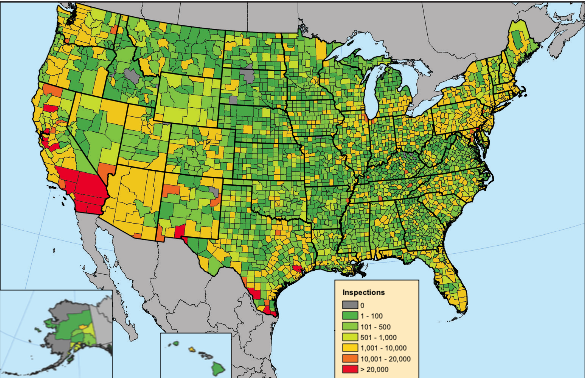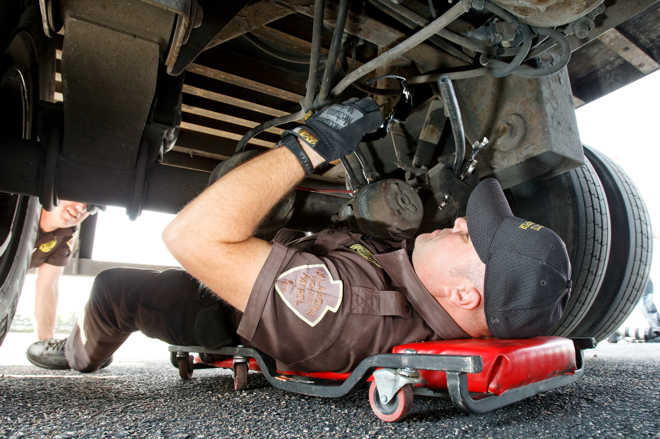Overview of Roadside Inspections
A roadside inspection of CMVs is a process in which a law enforcement officer or another designated official stops a commercial vehicle to inspect it for compliance with federal and state safety regulations.
The inspection typically includes a visual examination of the vehicle and its cargo, as well as a review of the driver’s record of duty status and other relevant documentation. The officer may also ask the driver to perform a series of maneuvers, such as turning or backing up, to assess the driver’s ability to control the vehicle.
If any violations are found during the inspection, the driver and/or the trucking company may be cited and fined. Roadside inspections are an important part of maintaining road safety and are typically conducted randomly, without prior notice to the driver or trucking company.
Inspections and OOS Statistics
Statistics from the FMCSA show that 1 in 5 (21.11%) inspections by the DOT in 2021 lead to vehicles being placed out of service, while only 1 in 20 (5.9%) driver inspections lead to them being placed Out of Service (OOS).

According to the FMCSA, “an inspection is an examination of an individual commercial motor vehicle (CMV) and/or driver by an authorized safety inspector. State inspectors conduct approximately 95 percent of inspections, with the remainder conducted by Federal inspectors. The inspection determines whether the driver and/ or the CMV is in compliance with the Federal Motor Carrier Safety Regulations (FMCSRs) or the Hazardous Materials Regulations (HMRs), as appropriate. Serious violations result in the issuance of vehicle or driver out-of-service (OOS) orders. These violations must be corrected before the affected driver or vehicle can return to service. “
Here are some of the most common violations that get drivers and their vehicles placed out of service. Familiarizing yourself with these violations and the exemptions that go along with them can be a huge time saver in the event of a roadside inspection.
#1 – 383.23A2 Operating a CMV without a CDL (~99.1% OOS)
Drivers have been required to have a commercial driver’s license (CDL) in order to drive certain commercial motor vehicles (CMVs) since April 1, 1992. The Federal Motor Carrier Safety Administration (FMCSA) has developed and issued standards for State testing and licensing of CDL holders. These standards require States to issue CDLs to certain CMV drivers only after the driver passes knowledge and skills tests administered by the State and related to the type of vehicle the driver expects to operate.
Drivers are required to obtain and hold a CDL if they operate in interstate, intrastate, or foreign commerce and drive a vehicle that meets one or more of the classifications of a CMV described below.
Class A:
Any combination of vehicles that has a gross combination weight rating or gross combination weight of 26,001 pounds or more whichever is greater, inclusive of a towed unit(s) with a gross vehicle weight rating or gross vehicle weight of more than 10,000 pounds whichever is greater.
Class B:
Any single vehicle that has a gross vehicle weight rating or gross vehicle weight of 26,001 pounds or more, or any such vehicle towing a vehicle with a gross vehicle weight rating or gross vehicle weight that does not exceed 10,000 pounds.
Class C:
Any single vehicle, or combination of vehicles, that does not meet the definition of Class A or Class B but is either designed to transport 16 or more passengers, including the driver or is transporting material that has been designated as hazardous under 49 U.S.C. 5103 and is required to be placarded under subpart F of 49 CFR Part 172 or is transporting any quantity of a material listed as a select agent or toxin in 42 CFR Part 73.
#2 – 395.8AELD- ELD-No record of duty status (~95.2% OOS)
Regulations require drivers to keep a record of duty status current to the time of the last change of duty status (whether or not the record has been signed).
Best practices and common answers to questions can be found at fmcsa.dot.gov/regulations/title49/section/395.8
For carriers, section 395.8(k)(1) requires motor carriers to retain all supporting documents at their principal places of business for 6 months from the date of receipt.
Supporting documents are the records of the motor carrier which are maintained in the ordinary course of business and used by the motor carrier to verify the information recorded on the driver’s record of duty status.
Examples include bills of lading, carrier pros, freight bills, dispatch records, electronic mobile communication/tracking records, gate record receipts, weight/scale tickets, fuel receipts, fuel billing statements, toll receipts, toll billing statements, port of entry receipts, cash advance receipts, delivery receipts, lumper receipts, interchange and inspection reports, lessor settlement sheets, over/short and damage reports, agricultural inspection reports, driver and vehicle examination reports, crash reports, telephone billing statements, credit card receipts, border crossing reports, custom declarations, traffic citations, and overweight/oversize permits and traffic citations.
#3 – 395.8E False report of driver record of duty status (~66.9% OOS)
Drivers must be trained on proper duty status recording whether the records are kept on an Electronic Logging Device or in conventional Log Books. Failure to follow the regulations can cause problems during a roadside inspection, an FMCSA audit, and especially in the event of an accident. §395.8(e) specifically states that “making false reports shall make the driver and/or the carrier liable to prosecution.”
The best way to avoid these problems altogether is to have drivers plan trips and already know what duty statuses they will be switching between before they get there.
For drivers that run the same routes often, it shouldn’t take long for them to get in the groove of switching between duty statuses. But drivers who are always taking new routes or regularly switching delivery schedules must be familiar with all different duty statuses and the benefits of each. Not only to stay within the regulations but to maximize allowable driving time which equates to more money in everyone’s pocket.
Here’s a map showing what parts of the country have the highest rate of inspections. When estimating costs, it’s a good idea to take into account where drivers/trucks will spend the most amount of time and invest in training, inspections, and truck cleanliness in the locations with the highest probability of getting stopped.



